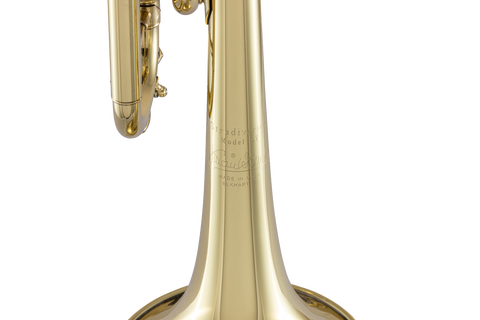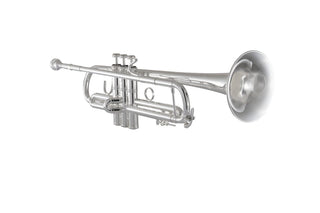UPDATE: Bach Brass has just updated their Stradivarius line with new and improved models, check out the new 190 series here!
This article refers to Stradivarius trumpets released prior to October 2023.
For info on serial numbers, please view Bach Serial Number List - Trumpet and Trombone
Bach trumpets have been around since 1925, when Vincent Bach sold his first trumpet in New York City, and for many years it has been the top choice brand of instrument for many students and professionals. Today, Bach trumpets are made by the Conn-Selmer company using the same quality standards that were used by Vincent Bach himself. If you have a Bach trumpet, you may have wondered what the engravings on the bell indicate.
It's a Bach Strad. What else do I need to know?
All of Bach's professional level trumpets are named "Stradivarius," but specifically each series begins with a three-digit number. The most popular series is currently the 180, but you may have a premium-model 190 Strad. These 190s are a step up from 180 and include a two-piece valve construction for improved resonance and response.
What does the model number mean?
This description can be a bit confusing, because the model number is usually etched onto the bell (e.g. Model 37), but it refers to the model of the bell, which is labeled according to its shape--which in turn affects the tone. Here are the most common bell models:

37 - The most commonly used bell on Bach Stradivarius trumpets, this bell allows the player the most versatility of sound.
43 - The second most common bell, it is a bit brighter than the 37.
72 - This bell gives the player a stronger, darker sound than the 37.
Other bell markings and stamps?
If your trumpet has these markings on the bell, it was made with some non-standard upgrades or construction! Bach has discontinued these options for the 180 series, but some can be found on current 190 series models.
Letter after the model number (ex: 37G, 43B, ect) - Different Bell Material, G is Gold Brass, B is Bronze, Y is Yellow Brass.
The new Bach 170 series features the Apollo 170S43GYR model, aka a 43 style bell that uses a Gold Brass stem and Yellow Brass flare.

Star (*) below the bell engraving - Lightweight Bell Thickness of 0.020", compared to the standard 0.025" Bach uses in their Elkhart factory. Your trumpet also features a lightweight construction, so the slide tubing is made of thinner Yellow Brass, versus standard Nickel Silver.
For example, the Stradivarius 180S37LT is fully made in lightweight yellow brass, resulting in more response and projection than a standard Strad. Think of it this way: the sound vibrations have less material and resistance to pass through before exiting your bell.

What about leadpipes?
If you currently play on a 180 or a 190, it's likely that you have a #25 leadpipe (sometimes called mouthpipe). Bach has found this design to be the best for all-around trumpet playing, and is not normally marked on the trumpet.
You may also see 25R stamped on your mouthpiece receiver (hexagonal portion), which indicates a (R)eversed leadpipe.
If you see a 25O instead, your leadpipe is a little larger and open than the standard #25 leadpipe. Other leadpipes can be requested for custom-built trumpets.
What about other letters in the name?
You may come across additional letters or number in the name. These indicate special options that are available by special order, or at some retailers.
LT indicates lightweight construction.
Non-standard bore sizes are indicated with M, L, or XL (standard bore size is ML, medium large).
Non-standard bell material is indicated with a letter after the bell number (B for bronze).
So how does that all work together?
Bach trumpet naming conventions make it simple to identify the features on new trumpets. The series number is the first number, and the bell model is the last. A letter in between (S) will usually indicate whether or not the trumpet is silver plated. Here are some examples:
18037 means you have a Bach Stradivarius 180 with a 37 bell.
180S37R means you have a Bach Stradivarius 180, (S)ilver plated with a 37 bell and (R)eversed leadpipe.
190S43 means you have a Bach Stradivarius 190, (S)ilver plated, with a 43 bell.
What if my bell says something else, like Mt. Vernon?
If your trumpet's bell says "Mt. Vernon," or even "New York," lucky you! You have a classic version of the Strad! Before Elkhart, Indiana, Vincent Bach built trumpets in Mt. Vernon, New York, and before that, New York City. These trumpets were built in the 1950s and 1960s and are coveted by professionals and collectors. If you have one of these sought-after models, you may have a different bell or leadpipe than what was mentioned above, as they do not follow today's naming conventions.
Changes are coming
As mentioned at the top of the article, Bach has introduced a brand new lineup of Stradivarius trumpets. Stop by Houghton Horns and try out one of our awesome Strads today!


Tim Lyon
Back in late 70’s I had a back strat. Some friends had a star on the bell, I did not. What did the star mean?
Anonymous
Hi John, that’s a great idea! I’ve added it to our list of future blog topics. —Kacie
Anonymous
A more inclusive article including Bach C, D, Eb, etc. instruments, bell types, and serial number dates would be appreciated.